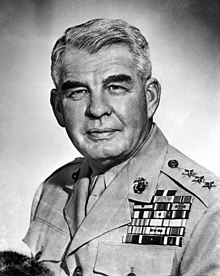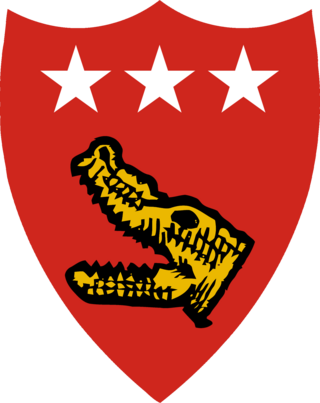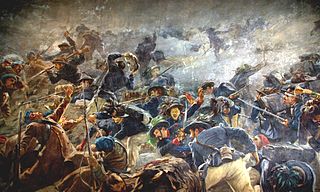United States
- All units and personnel are USMC unless otherwise noted.

Expeditionary Troops (Lieutenant General Holland M. Smith) [1]
Contents
- Chief of Staff: Brigadier General Graves B. Erskine [1]

![]() V Amphibious Corps (Harry Schmidt) [2]
V Amphibious Corps (Harry Schmidt) [2]
- Chief of Staff: Brigadier General Graves B. Erskine [2]
- V Amphibious Corps Headquarters and Service Battalion (Major Thomas R. Wert) [2]
- V Amphibious Corps Amphibious Reconnaissance Battalion (Captain James L. Jones) [2]
- V Amphibious Corps Medical Battalion (Lieutenant Commander William B. Clapp (USN)) [2]
- V Amphibious Corps Signal Battalion (Colonel James H. N. Hudnall) [3]
- V Amphibious Corps Motor Transport Company [4]
- V Amphibious Corps Provisional Engineer Group [4]
- 18th Naval Construction Battalion (USN) [4]
- 121st Naval Construction Battalion (USN) [4]
- 34th Engineer Combat battalion (USA) [4]
- 2nd Armored Amphibian Battalion (Lieutenant Colonel Reed M. Fawell Jr.) [3]
- 4th 105mm Howitzer Battalion (Lieutenant Colonel Douglas E. Reeve) [3]
- 17th Anti-Aircraft Artillery Battalion [4]
- 7th Field Depot (Colonel Earle H. Phillips) [3]
- 3rd Ammunition Company [4]
- 18th Depot Company [4]
- 19th Depot Company [4]
- 20th Depot Company [4]
- 31st Field Hospital (USA) [1]
- 96th Provisional Portable Surgical Hospital (USA) [4]
- 97th Provisional Portable Surgical Hospital (USA) [4]
- 98th Provisional Portable Surgical Hospital (USA) [4]
- Air Warning Squadron 5 [1]
- Detachment, 680th Air Warning Company (USA) [1]
- Detachment, 726th Air Warning Company (USA) [1]
- Detachment, 763th Air Warning Company (USA) [1]
- Detachment, Mobile Communications Unit No. 18, Group Pacific 6 (USN)
- Northern Troops and Landing Force Shore Party (Colonel Cyril W. Martyr) [4]
- Attached units
-
 XXIV Corps Artillery (Brigadier General Arthur M. Harper) (USA) [1]
XXIV Corps Artillery (Brigadier General Arthur M. Harper) (USA) [1] - 419th Field Artillery Group (USA) [5]
- 145th Field Artillery Battalion (USA) [5]
- 225th Field Artillery Battalion (USA) [5]
- 420th Field Artillery Group (USA) [5]
- 531st Field Artillery Battalion (USA) [5]
- 532nd Field Artillery Battalion (USA) [5]
- 419th Field Artillery Group (USA) [5]
- Provisional Anti-Aircraft Artillery Group (USA) [1]
- 864th Aircraft Warning Anti-Aircraft Battalion (USA) [1]
- Battery A, 751st Anti-Aircraft Battalion (USA) [1]
- Battery B, 751st Anti-Aircraft Battalion (USA) [1]
-
 27th Infantry Division Artillery (Brigadier General Richmond F. Kernan) (USA) [1]
27th Infantry Division Artillery (Brigadier General Richmond F. Kernan) (USA) [1] - 104th Field Artillery Battalion (Lieutenant Colonel George P. Van Nostrand) (USA) [1]
- 105th Field Artillery Battalion (Lieutenant Colonel Nicholas D. La Morte) (USA) [1]
- 106th Field Artillery Battalion (Lieutenant Colonel John J. Fitzgerald) (USA) [1]
- 249th Field Artillery Battalion (Lieutenant Colonel Dwight McCallum) (USA) [1]
- 477th Amphibious Truck Company (USA) [1]
-


-
 2nd Marine Division (Major General Thomas E. Watson)
2nd Marine Division (Major General Thomas E. Watson) - Assistant Division Commander: Brigadier General Merritt A. Edson [3]
- Chief of Staff: Colonel David M. Shoup [3]
-
 2nd Marine Regiment ( Colonel Walter J. Stuart)
2nd Marine Regiment ( Colonel Walter J. Stuart) - 1st Battalion (Lieutenant Colonel Wood B. Kyle) [3]
- 2nd Battalion (Lieutenant Colonel Richard C. Nutting) [3]
- 3rd Battalion (Lieutenant Colonel Arnold F. Johnston) [3]
-
 6th Marine Regiment (Colonel James P. Riseley)
6th Marine Regiment (Colonel James P. Riseley) - 1st Battalion (Lieutenant Colonel William K. Jones) [3]
- 2nd Battalion (Lieutenant Colonel Raymond L. Murray) [3]
- 3rd Battalion ( †Lieutenant Colonel John W. Easley; Major John E. Rentsch from 2 August 1944) [3]
-
 8th Marine Regiment (Colonel Clarence R. Wallace) [3]
8th Marine Regiment (Colonel Clarence R. Wallace) [3] - 1st Battalion (Lieutenant Colonel Lawrence C. Hays Jr.) [3]
- 2nd Battalion (Lieutenant Colonel Henry P. Crowe) [3]
- 3rd Battalion (Lieutenant Colonel John C. Miller Jr.) [3]
-
 10th Marine Regiment (Artillery) (Colonel Raphael Griffin) [3]
10th Marine Regiment (Artillery) (Colonel Raphael Griffin) [3] - 1st Battalion (Lieutenant Colonel Presley M. Rixey) [3]
- 2nd Battalion (Lieutenant Colonel George R. E. Shell) [3]
- 3rd Battalion (Major William L. Crouch) [3]
- 4th Battalion (Lieutenant Colonel Kenneth A. Jorgensen) [3]
-
 18th Marine Regiment (Engineer) (Lieutenant Colonel Ewart S. Laue [lower-alpha 1] )
18th Marine Regiment (Engineer) (Lieutenant Colonel Ewart S. Laue [lower-alpha 1] ) - 1st Battalion, 18th Marines (Lieutenant Colonel August L. Vogt) [7]
- 2nd Battalion, 18th Marines (Lieutenant Colonel Chester J. Salazar) [7]
- 2nd Medical Battalion (Lieutenant Commander Claude R. Bruner (USN)) [3]
- 2nd Motor Transport Battalion (Major Milton J. Green) [3]
- 2nd Service Battalion (Major Edward V. Dozier) [3]
- 2nd Tank Battalion (Major Charles W. McCoy) [3]
- 2nd Amphibian Tractor Battalion (Major Fenlon L. Durand) [3]
- 5th Amphibian Tractor Battalion (Major George L. Shead) [3]
- Attached units
- 1st Amphibious Truck Company [8]
- 715th Amphibian Tractor Battalion (USA) [8]
- 2nd 155mm Artillery Battalion [8]
- 1st Provisional Rocket Detachment [8]
- 2nd Joint Assault Signal Company (USA) [8]
- Underwater Demolition Team 5 (USN) [9]


-
 4th Marine Division (Major General Clifton B. Cates) [7]
4th Marine Division (Major General Clifton B. Cates) [7] - Assistant Division Commander: Brigadier General Samuel C. Cumming [7]
- Chief of Staff: Colonel William W. Rogers [7]
-
 14th Marine Regiment (Artillery) (Colonel 'Louis G. DeHaven)
14th Marine Regiment (Artillery) (Colonel 'Louis G. DeHaven) - 1st Battalion ( †Lieutenant Colonel Harry J. Zimmer; Major Clifford B. Drake from 25 July 1944) [7]
- 2nd Battalion (Lieutenant Colonel George B. Wilson Jr.) [7]
- 3rd Battalion (Major Robert E. MacFarlane) [7]
- 4th Battalion (Lieutenant Colonel Carl A. Youngdale) [7]
-
 20th Marine Regiment (Engineer) (Lieutenant Colonel Nelson K. Brown) [7]
20th Marine Regiment (Engineer) (Lieutenant Colonel Nelson K. Brown) [7] - 1st Battalion (Engineers) (Major Richard G. Ruby) [7]
- 2nd Battalion (Pioneers) (Major John H. Partridge) [7]
-
 23rd Marine Regiment (Colonel Louis R. Jones) [10]
23rd Marine Regiment (Colonel Louis R. Jones) [10] - 1st Battalion (Lieutenant Colonel Ralph Haas) [10]
- 2nd Battalion (Lieutenant Colonel Edward J. Dillon) [10]
- 3rd Battalion (Major Paul S. Treitel) [10]
-
 24th Marine Regiment (Colonel Franklin A. Hart) [10]
24th Marine Regiment (Colonel Franklin A. Hart) [10] - 1st Battalion (Lieutenant Colonel Otto Lessing) [10]
- 2nd Battalion (Major Frank E. Garetson; Lieutenant Colonel Richard Rothwell from 27 July 1944) [10]
- 3rd Battalion (Lieutenant Colonel Alexander A. Vandegrift Jr.) [10]
-
 25th Marine Regiment (Colonel Merton J. Batchelder) [10]
25th Marine Regiment (Colonel Merton J. Batchelder) [10] - 1st Battalion (Lieutenant Colonel Hollis U. Mustain) [10]
- 2nd Battalion (Lieutenant Colonel Lewis C. Hudson) [10]
- 3rd Battalion (Lieutenant Colonel Justice M. Chambers) [10]
- 4th Medical Battalion (Lieutenant Commander George W. Mast (USN)) [7]
- 4th Motor Transport Battalion (Lieutenant Colonel Ralph L. Scheisswohl) [7]
- 4th Service Battalion (Colonel Richard H. Schubert) [7]
- 4th Tank Battalion (Major Richard K. Schmidt) [7]
- 10th Amphibian Tractor Battalion (Major Victor J. Croizat) [11]
- Attached units
- Company C, 11th Amphibian Tractor Battalion [11]
- 534th Amphibian Tractor Battalion (USA) [11]
- 708th Amphibian Tank Battalion (USA) [11]
- 773rd Amphibian Tractor Battalion (USA) [11]
- 1st Joint Assault Signal Company (USA) [11]
- 2nd Amphibious Truck Company [11]
- 311th Port Company (USA) [11]
- 539th Port Company (USA) [11]
- 1st Provisional Rocket Detachment [11]
- Underwater Demolition Team 7 (USN) [9]















